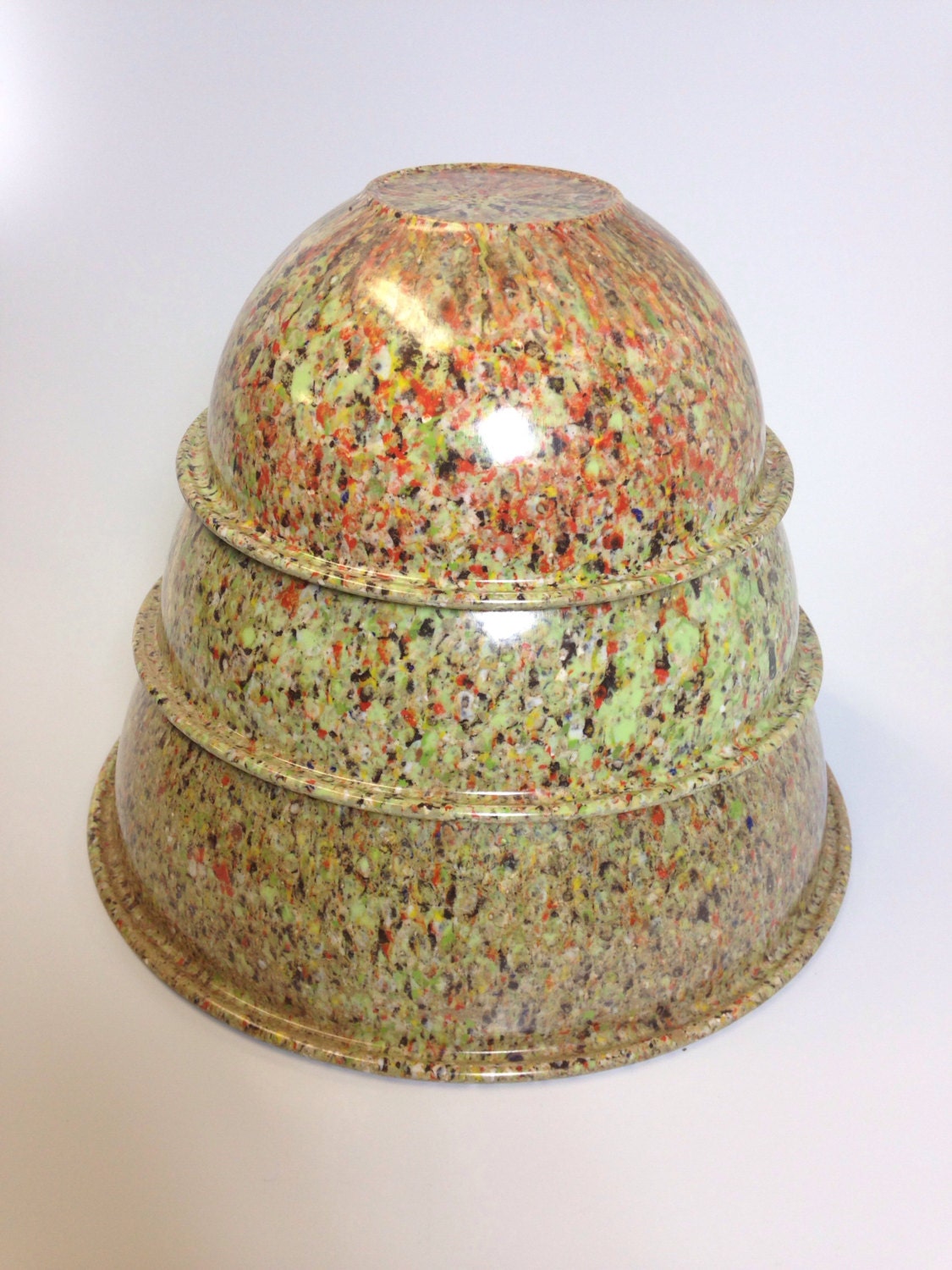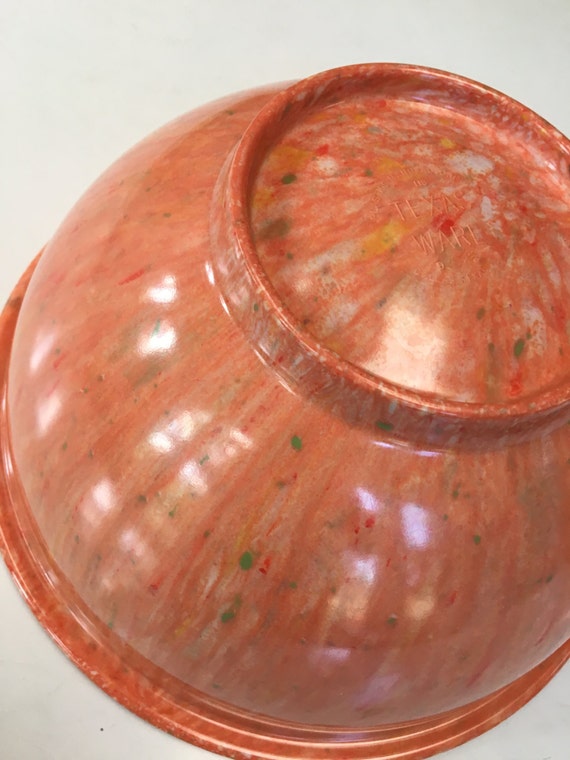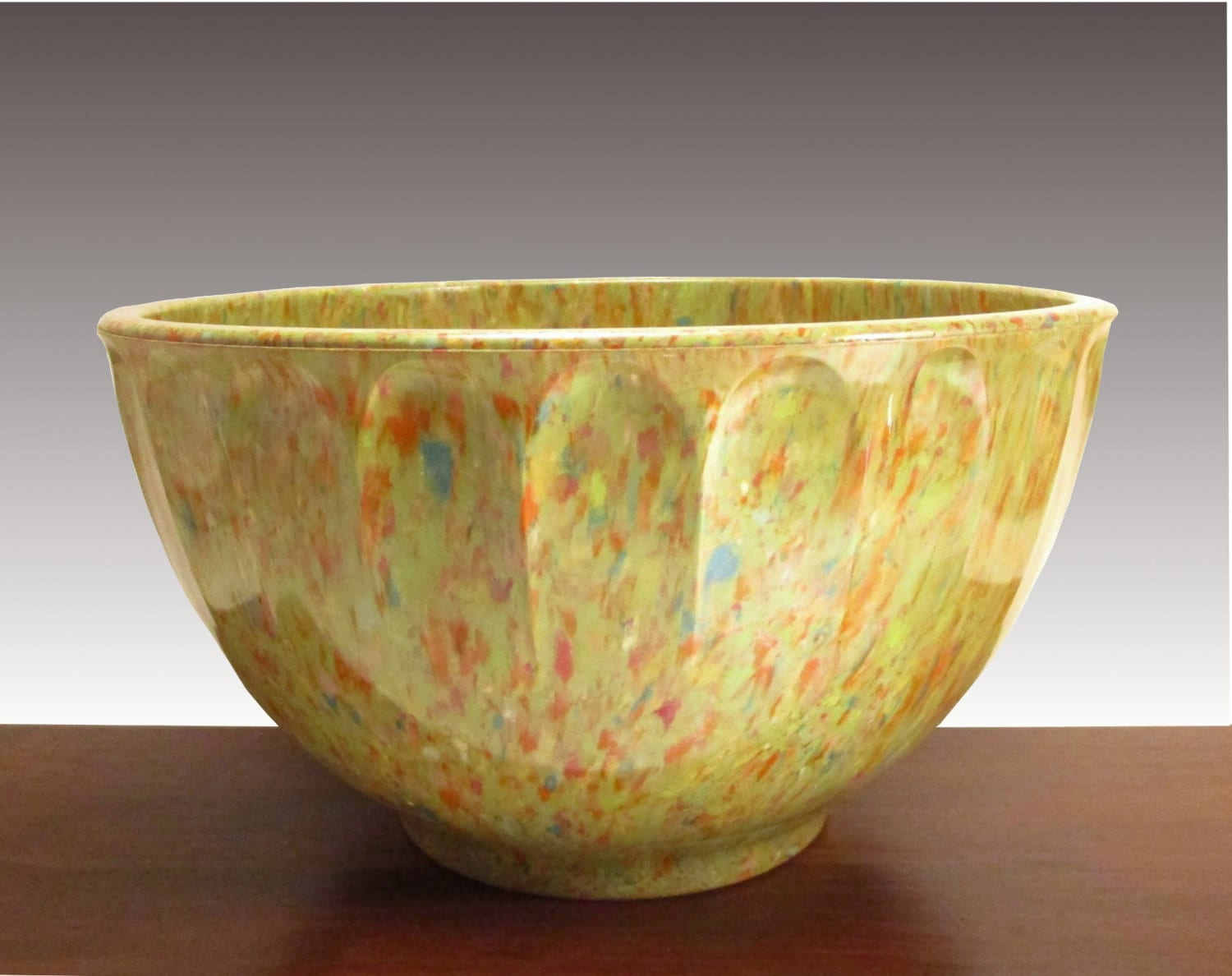Speckled Texasware Mixing Bowls from Etsy Shop Museum of Kitsch
Speckled and Spattered the Texasware Bowl Comes to Life
Thanks to this blog and my articles on Melmac on the web, I have heard from readers all over the world, and I have been fortunate enough to hear from the grandchildren of the owner of Plastics Manufacturing Company, who produced Texasware melamine dinnerware among other plastics. "Gary Joy's" grandfather started the company, but dad also worked there, up until he passed in 1983. The company was since sold but technically heir to the original owners, so pardon the reference.
"My grandfather started Plastics Mfg. Co. in Dallas in the late 40s - my father ran the company until his death in 1983. For many years it was the largest manufacturer of melamine dinnerware in the world, as well as the only plastic dinnerware sold at Neiman-Marcus! I worked in the outlet store while in college in the early 70s - Gary Joy "
In simple terms, back in the heydey, PMC was the BIG BOY of dish production. Smaller molders would buy melamine molding powders or melmac formula powders to mold plastic dishes; but not PMC! They were making their own powders and dishes. In technical terms, they were producing laminating paper, laminating resins, melamine moulding compounds, urea molding compound and 135 resin of production to name a few circa 1979.
I will simply state that this simple story is a great example of America's industrialism and a family run business. Thank you so much for reaching out to me, my readers will love this story.
Pic: By U.S. Air Force [Public domain], via Wikimedia Commons
When Granddad switched to making tabletops for awhile, and finally mainstreamed into dinnerware, I wonder if perhaps this move would be the most profitable one at the time? Perhaps really, the most historical decision he ever made. Every time I look at a Texasware dish now, I will wonder what possessed a man who was molding aircraft parts and laminated tables to dabble in the dishes?
When her father went to work for the Company, he was an innovator and she explains, "He did things other companies could not do. Dad took a bunch of scraps and made the first speckled bowl. He brought it home and Mom thought it was hideous. "
Poof , just like that, a speckled bowl was made. Isn't that ironic, throwing a bunch of scrap pieces together and making history? Perhaps some of the best creations are made in error, or on the fly. Texas Ware's mottled mixing bowls have become a collector's dream and I'm very thankful (for once) we have a man who didn't listen to his wife's opinion on style and design. These treasures may have never existed.
But Wait Who Was First?
Back in the day I was in a group of four friends and we vehemently discussed melmac and for the sake of journalism, our big discussion was who was first to market. In this instance, I think it's important who was BEST to market. I have seen early examples of Boontonware mixing bowls and later examples of Brookpark mixing bowls (closest in design and confetti mottling to Texasware-see below). Perhaps you will agree PMC / Texasware was known for these bowls.
Even more confusing, I see so many speckled, confetti, or spattered melamine dishes erroneously tagged Texasware, as there is a plethora of people who assume anything with speckles is called Texasware, which it's not.
Now granted, for the sake of unbiased reporting, I can't be certain this was "the holy grail" of speckling, and keep in mind this wasn't uncommon for employees at plastics plants or even companies to make "end of day" dinnerware with left over scraps. I've seen early examples of Beetleware with speckles plus a lot of glittery 50's flexible kitchen plastics. I've written about Russel Wright's speckled melamine items circa 1953 and Northern Melamine's end of day wares, so we could get all technical on who put the first bit speck or stipple or mottle in the dish or in the plastic, but we won't go there because who has time for that?
First mottle in plastic? I wouldn't be surprised if a defunct plastic molder made a sewing button and was first to spatter or speckle plastics, out of pure necessity and need for buttons hence, perhaps we will never know.
I'm simply discussing the magnitude of the design impact of Texas Ware Bowls. So call it what you will, Spatterware , Speckled, Mottled, Confetti, or even Dabbled or Spotted, but you will not find anything as amazing.
Look for yourself, anything similar to the Texasware in the bowls you see on this Etsy page or just so-so blazay-blazay spatters and speckle?
Above: Speckled Melmac for sale on Etsy search term : Spatterware+Melmac
Retro Replacements has these for sale, look like TexasWare but they are Brookpark.
Texas Ware Bowl lovely at best. Note the footed ridge. Found: @mightyMODERN
Boonton's Mixing Bowl note, this is heavy mottling, most I have seen are less mottled and less prominent. This is a beauty found @PieInSkyVintage
I guess that's more about bowls that you want to know, but as someone famous once said there are no mistakes in life, just happy accidents.
Thanks for reading!
Part Two Coming Soon Wait for Part Two, where Gary Joy explains more about the Small Fry Originals...Coming soon....
I encourage sharing of my blog but please note if you wish to reference any part of this article you must adhere to my Content policy. Thanks.







